Photos: Quinn Hamill
data-animation-override>
“At first glance, Steve Gooch’s Ford Thunderbird may look like a rust bucket, but take a closer look and you will soon see it’s a work of art”
“People always ask me when I’m going to paint it,” says Steve Gooch, chuckling as the two of us sit around a table at the back of NZV8’s central Auckland studio. As always, it’s dark in the large white room but for the occasional bright flash from the big studio lights. Each time I hear the soft, muted pop of the firing flashes, I catch a glimpse of the rough, muscular lines of Steve’s hulking 1958 Ford Thunderbird lurking at the other end of the building. “I’ll be honest Steve,” I reply, “This car might just be the greatest thing I’ve ever laid eyes on.”
I’m sure if I am ever successful enough with a woman to produce a child of some kind, I might say otherwise, but for the moment, Steve Gooch’s 1958 Thunderbird is indeed the single best thing I’ve ever seen. A huge, rumbling machine with about as much anti-cookie-cutter bravado as any car ever to grace these pages. There simply isn’t anything else like it in New Zealand.
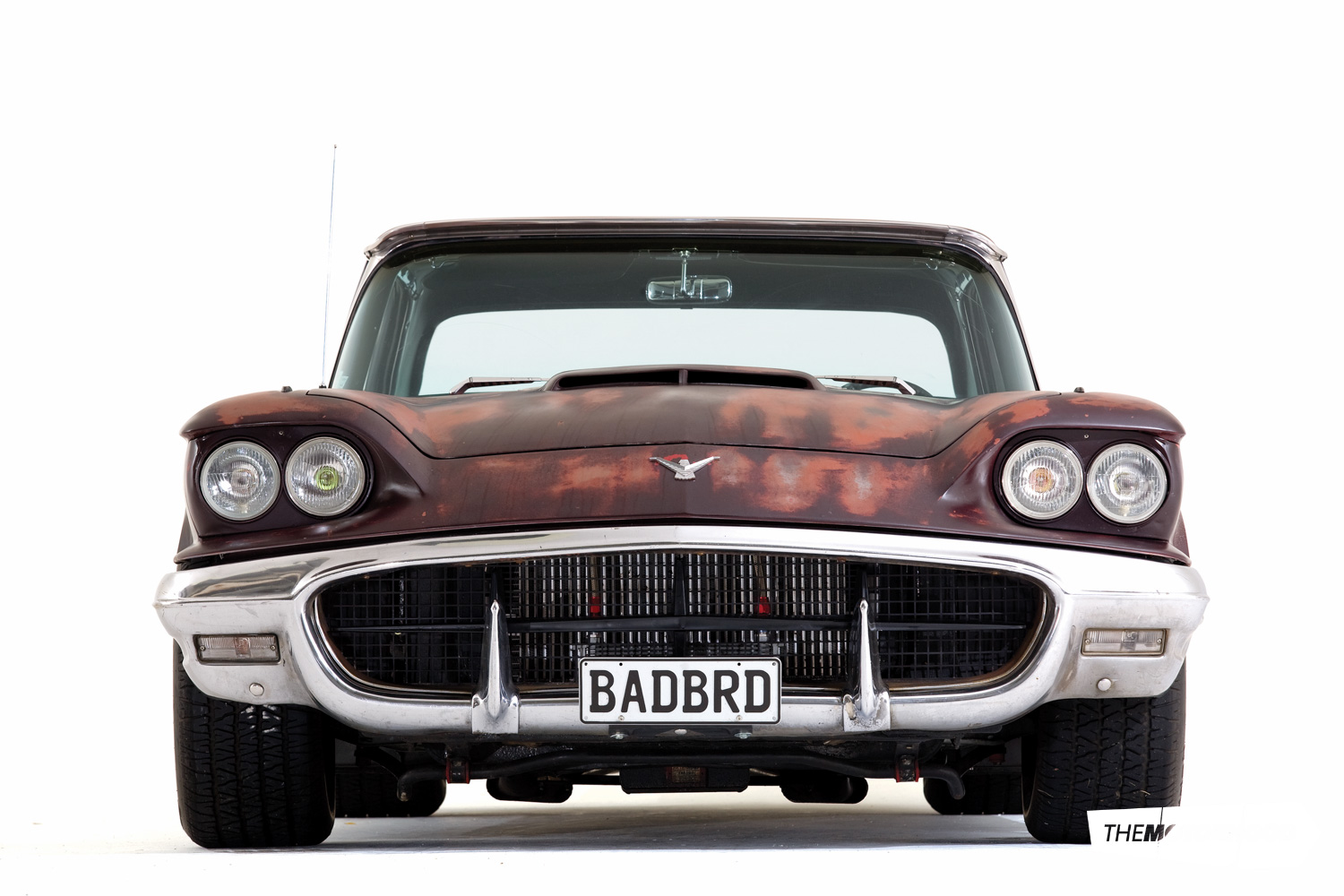
When Steve answers the paint question with, “What are you talking about? It is painted!” he is most often met with quizzical looks, which quickly transform to grins as people take a closer look at the unique coupe. Sure enough, this is a completely finished car, and many, many hours have gone into the exterior alone to get it to this point, even if it might not first appear that way. This is thanks to someone whom many regard as the best painter/airbrush artist in New Zealand, Steve Levine of Imagin-airing. “Originally I wanted to matte-black the car, but that is nothing new,” Gooch says. “Then I thought, why not build it to look like a ’50s Nascar racer? This, of course, has been done before, but no one has built a car to look like a ’50s Nascar racer that’s sat in a paddock for 40 years untouched.”
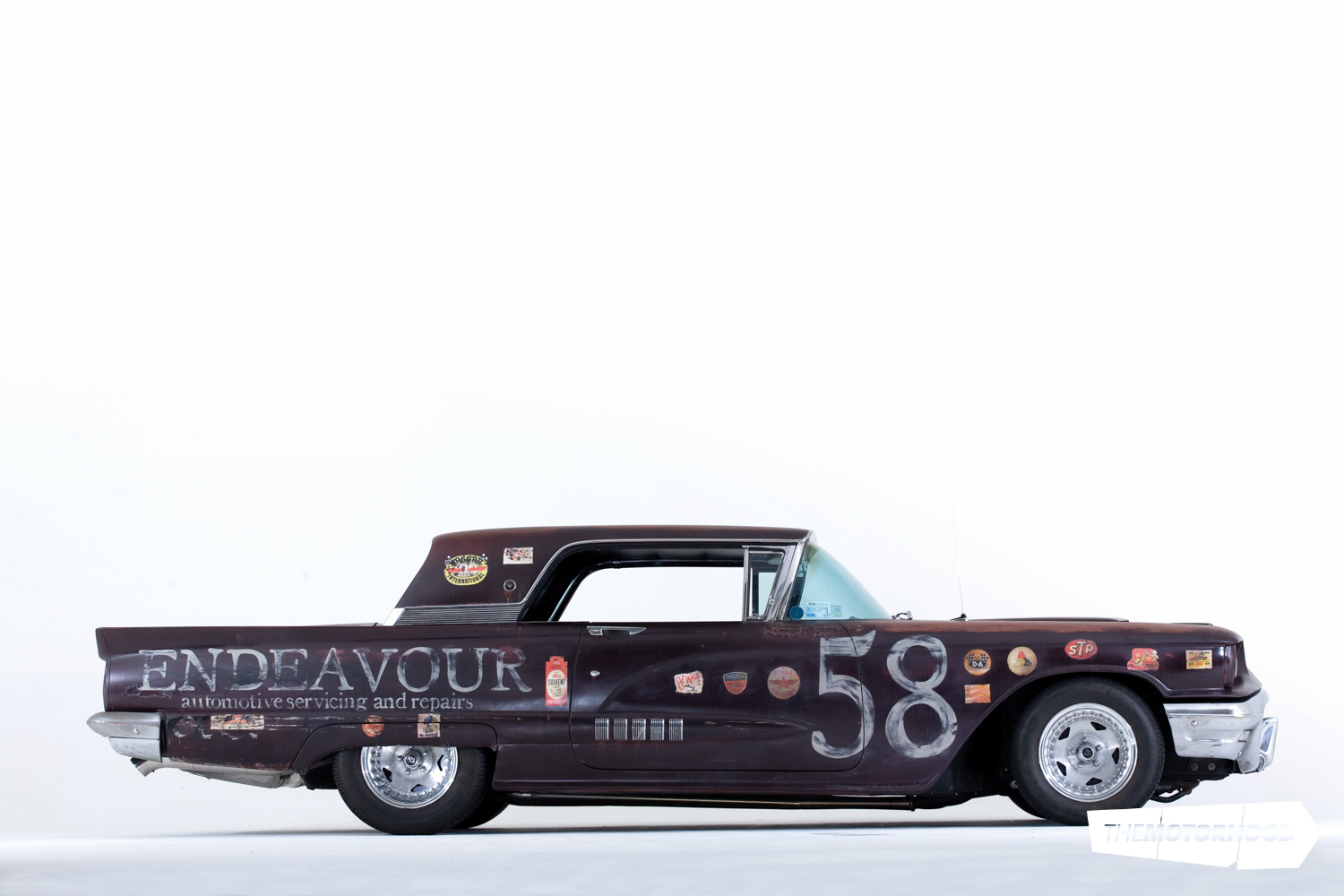
In terms of the car’s history, the T-bird really did sit in a paddock Stateside for many years. That gave Steve the look he was after, but also the wear and tear to go with it. Levine’s task was to repeat that look once the car was put back to a roadworthy condition.
The work was done over the space of a few months, using a variety of different techniques. Rust and discolouration were airbrushed, new retro stickers were sourced then purposely aged, and some of the original paint was baked and retained. Steve even went so far as to add scrub marks on one side of the car from a fictitious encounter with another Nascar racer — what a truly unique way to finish a vehicle. The end result is a visually stunning piece of machinery that is perhaps only bested in terms of toughness by the rumbling twin turbocharged 416ci bent eight sitting under the mottled hood.
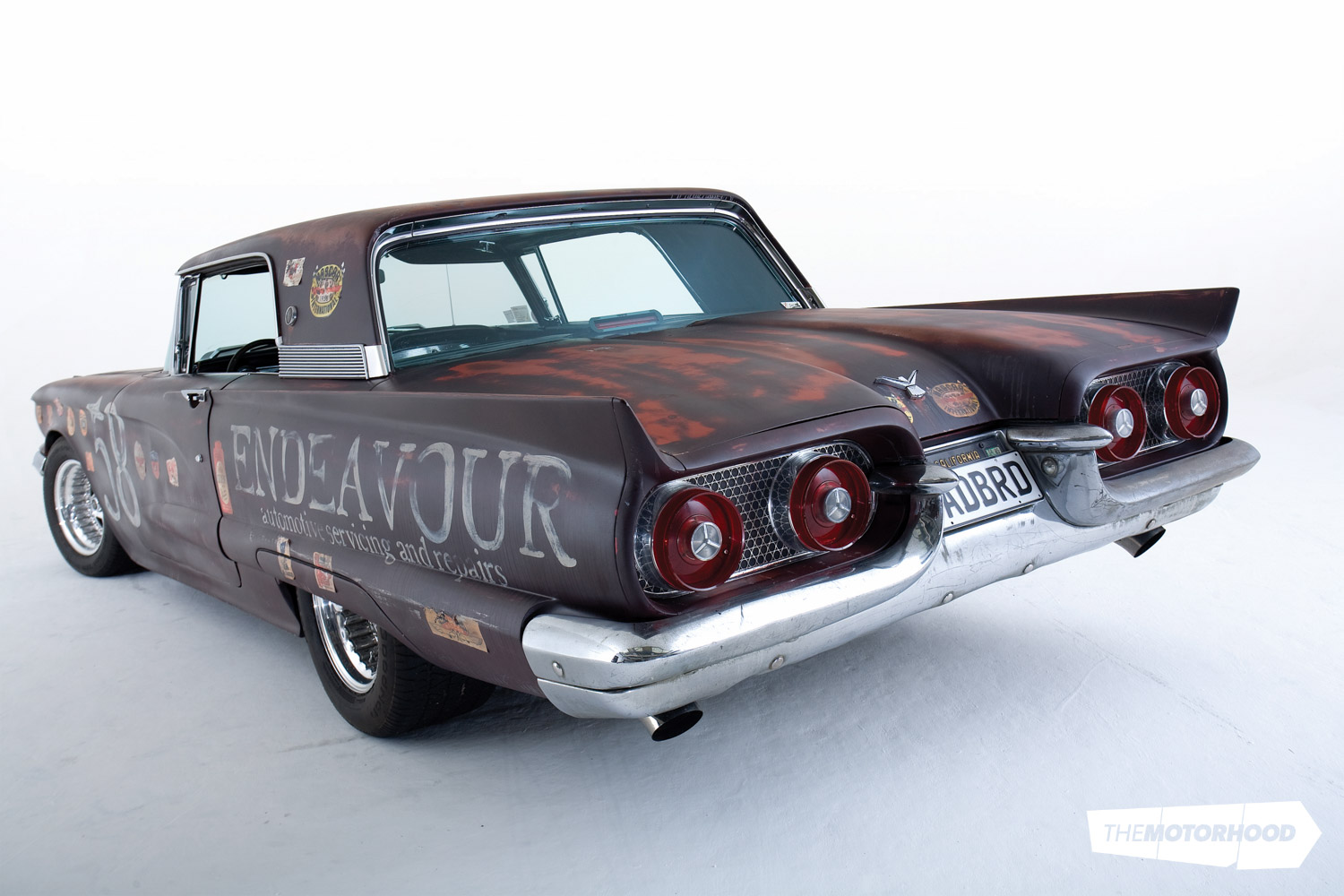
I ask Steve why he decided to go down the turbocharged route, as opposed to natural aspiration or supercharging. “When I was in the United Kingdom, the place I worked at specialised in Ford Escorts, Cosworths, Group B rally cars and other turbocharged vehicles like that. So I had a lot to do with huffers and I could see the potential in them,” he explains. “Back then there weren’t many turbo cars in New Zealand, unlike today. So I started telling people I was going to turbocharge my 416 Windsor, which I had built up before leaving the country, and put it in the T-Bird. Once you’ve told someone you are doing it, everyone knows about it and you can’t back out, so I had to go through with it.”
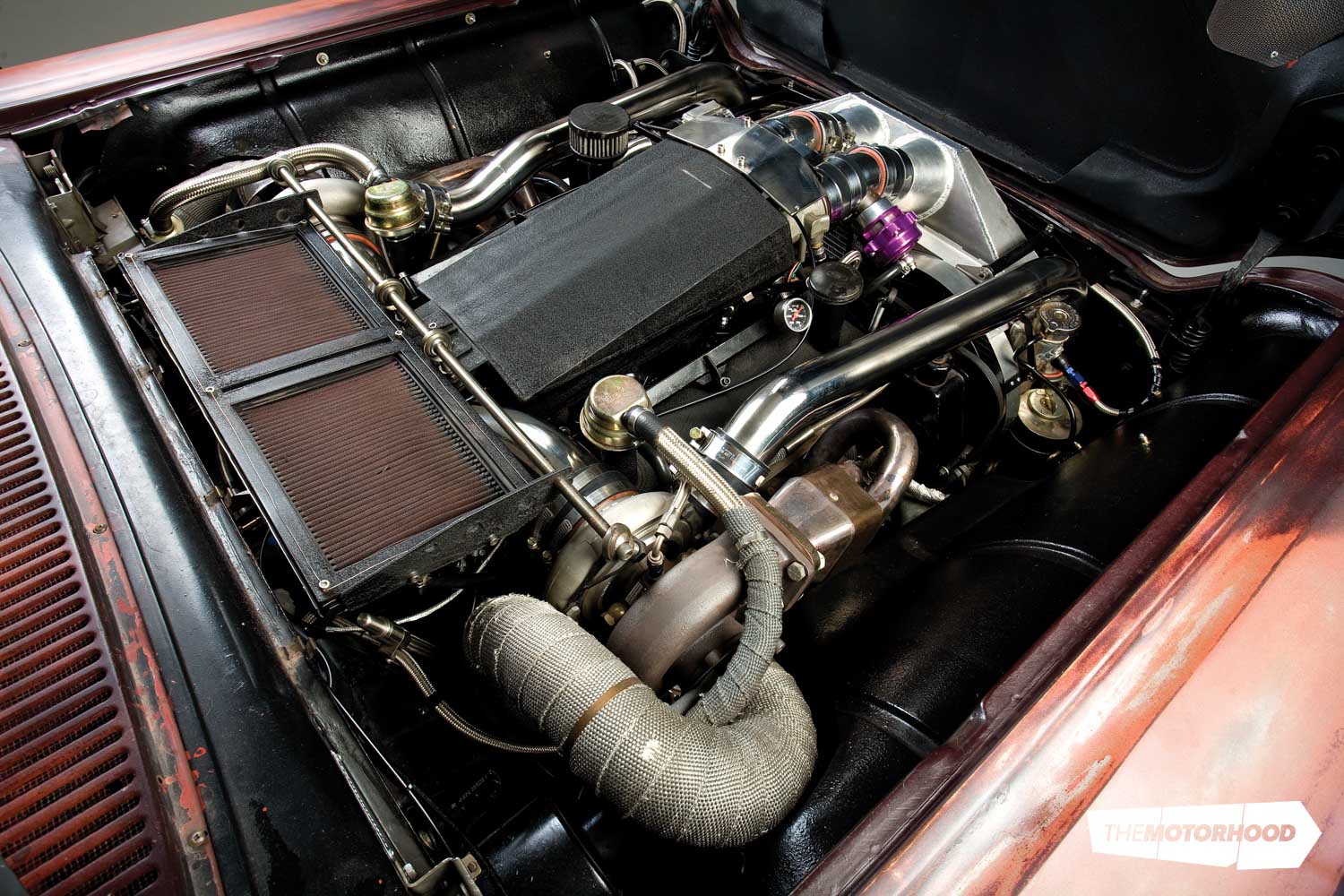
Steve originally built his motor well over a decade ago to fit into a Super Saloon car he had at the time. That never eventuated, and the hulking great lump of American iron has since sat on the garage floor for much of its life, until recently, of course. The 416 runs a 400 Cleveland crank, polished and shot peened Chrysler rods and a set of Ross forged pistons. A flat tappet cam spins through the middle of the motor. According to Steve the cam is too aggressive for its new application, but was what was required at the time. Up top the motor runs ported 4V Windsor heads, which contain stainless valves and custom roller rockers.
You might be wondering why “406ci” (equivalent to 6653cc) is painted on the bonnet if the car runs a 416. “Although the motor has done me well, it’s not perfect for this car,” Steve admits. “A 406, however, would be ideal, and parts are much easier to find, so the plan is to build up a new 406ci motor in the near future.”
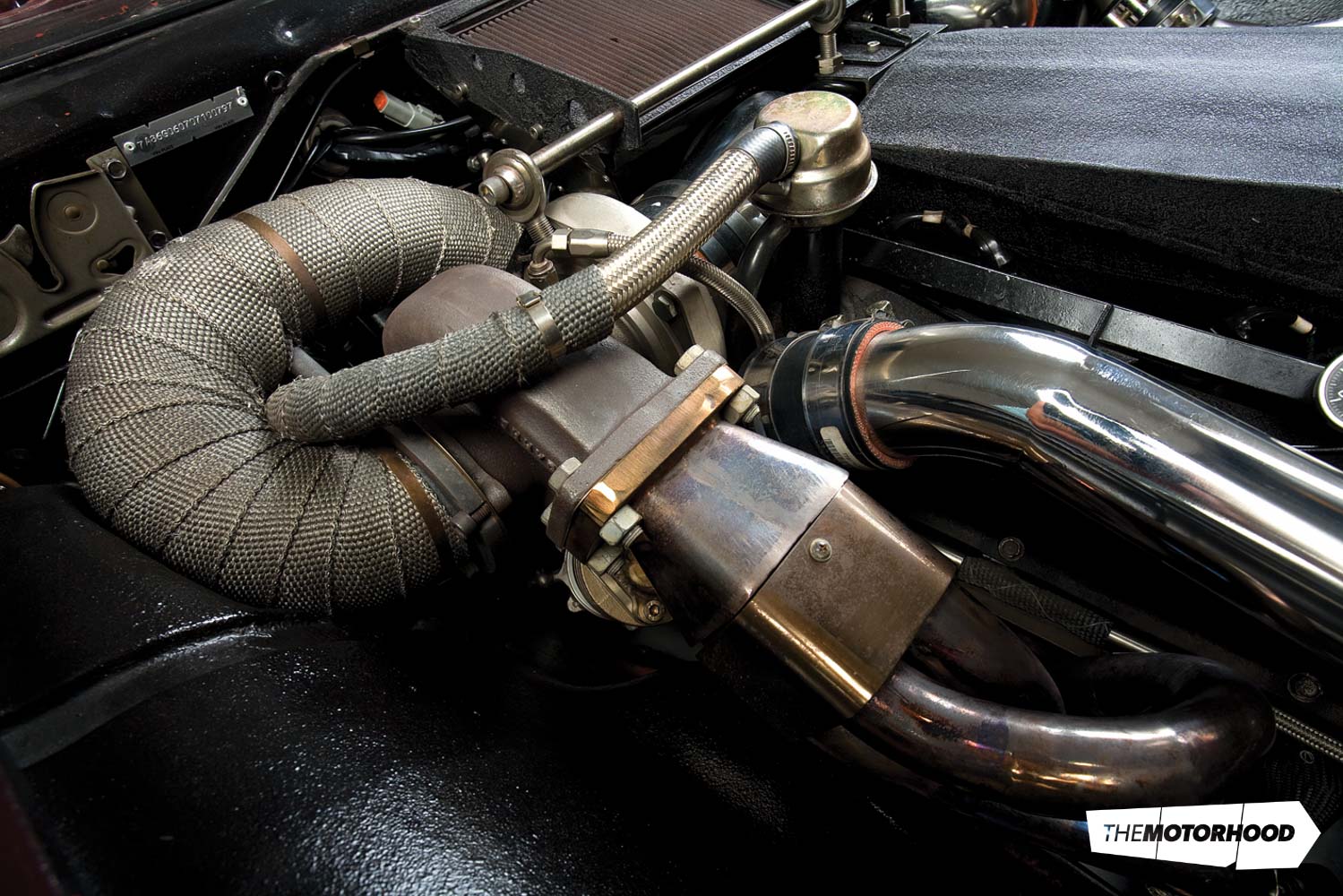
Even though the motor was built so long ago, it does a fine job of handling the extra power provided by two much newer Garrett GT35R turbochargers, one hanging off each side of the motor. These have been modified with 1.06 A/R exhaust housings, used to help build boost more quickly.
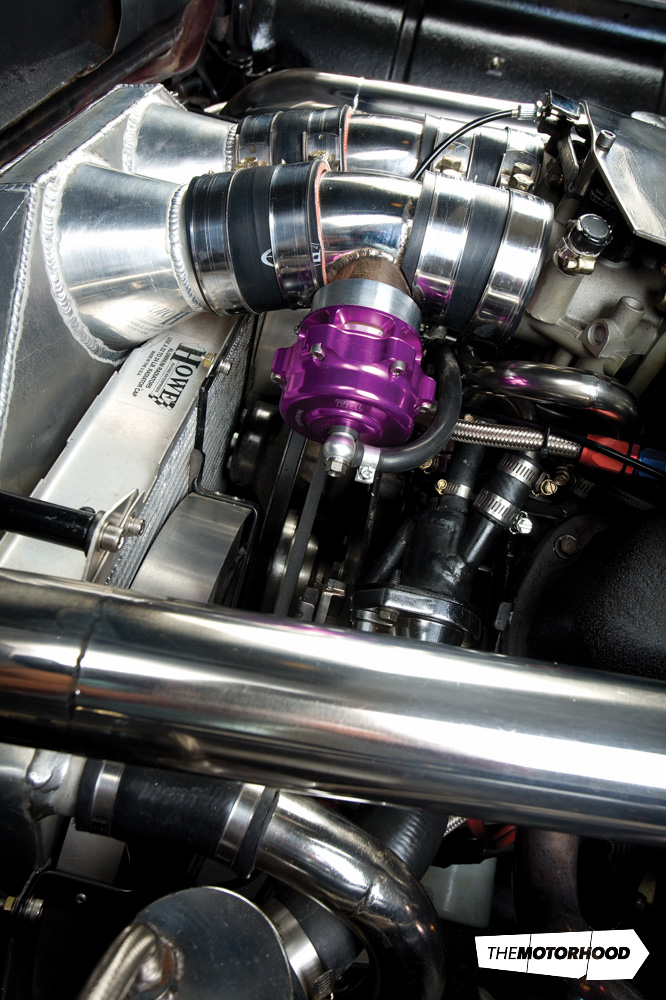
As there are plural chargers, there are two of many things, including blow-off valves, that prevent compressor surge (caused by the turbos spinning backwards), and external wastegates, used to regulate boost pressure accurately.
Steve has fabricated a very trick intake tract and plenum that pulls in cold air through the original bonnet scoop. The air is then pressurised by the turbos and crammed through a custom intercooler, sitting behind a triple pass Moroso radiator, and passes into the heads as efficiently as possible. The fact that it looks damn cool doesn’t hurt either.
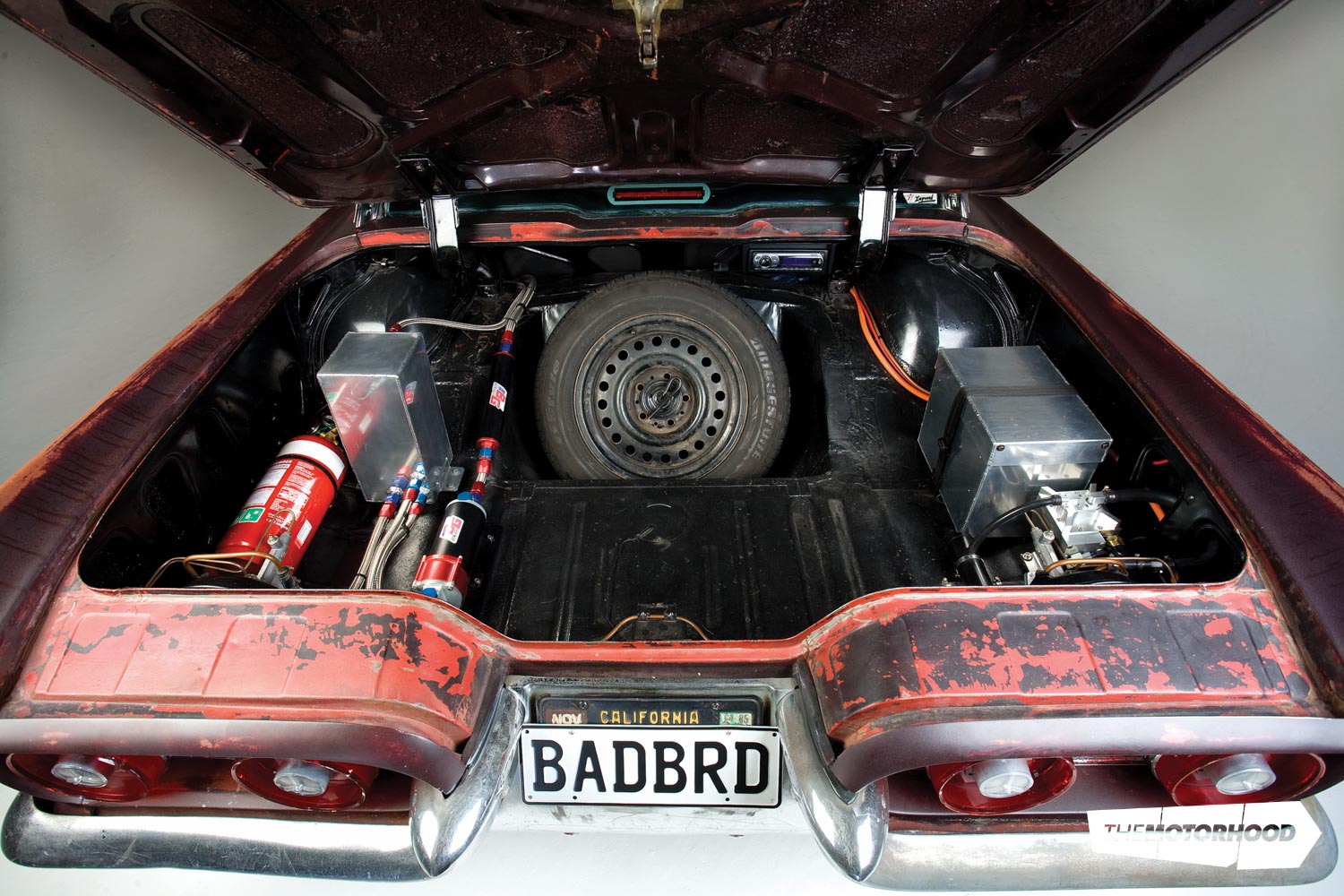
In terms of fuelling, Steve has built his system with the future in mind, speccing it with eight 1600cc Indy Blue injectors, a huge Barry Grant main pump and two supplementary lift pumps. Unlike many of the cars we see in NZV8 magazine, this Thunderbird is packing a little new-school tech to go with its old-school cool, and it sports an Aussie-made Autronic engine management system. This gives Steve huge tune-ability, and the potential for power is massive. Currently simmering on 720hp at the fly, the motor obviously has a lot more in it. Unfortunately, at 5500rpm the head gasket gave out and it was all over. According to Steve, 720hp is more than enough for now in any case. Give it a few more months, though, and who knows…?
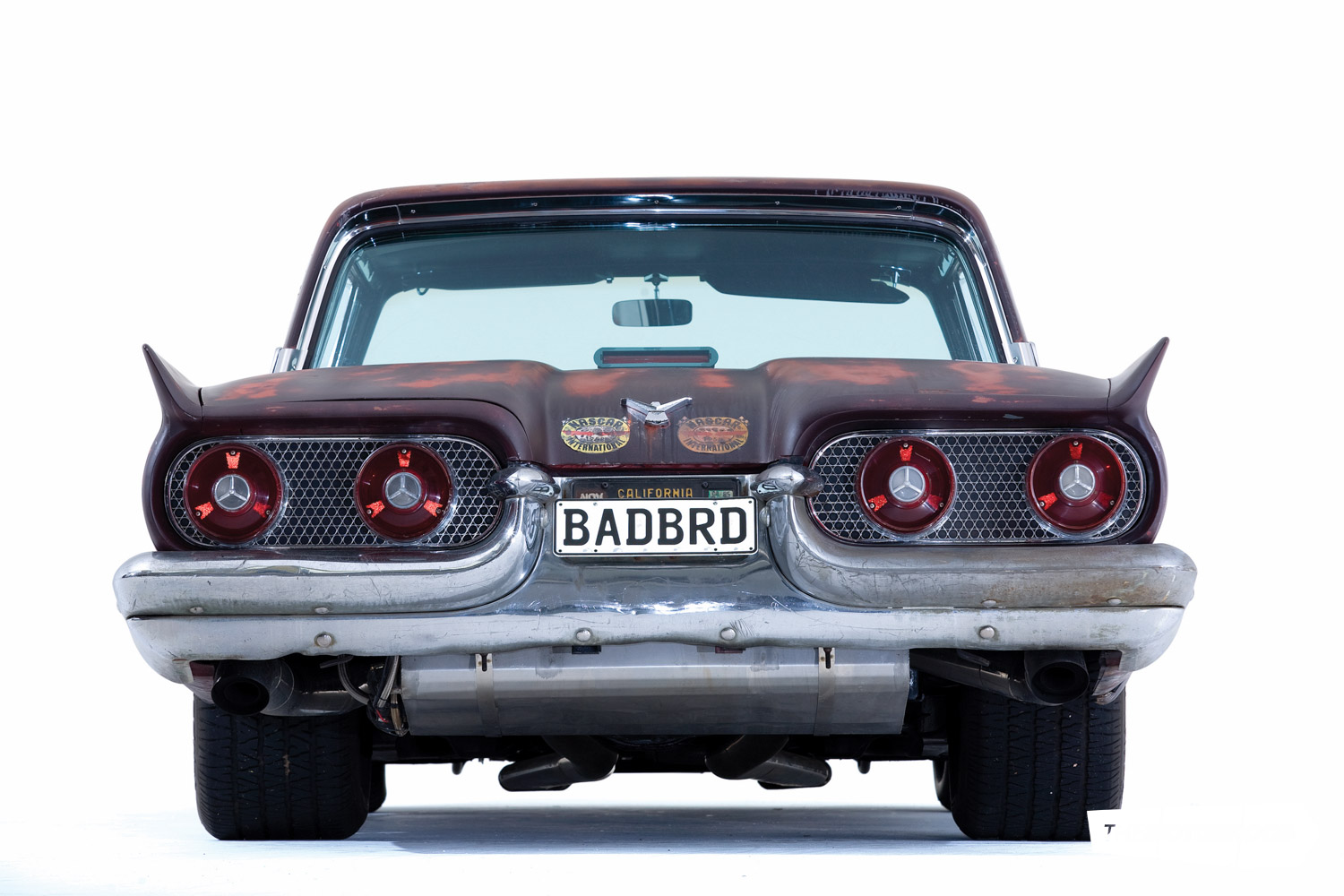
On the other side of the equation, a massive and intricate four-inch twin exhaust system pulls gases out to the rear of the car. The exhaust is oval, in the centre for extra ground clearance, and runs alongside a C6 transmission that has been improved with a heavy duty input shaft, four sets of Idler planetary gears, a flex plate clutch and a 3000rpm stall converter. The trans puts power out to the rear 15×10.5-inch Centreline Convo Pro rims through a heavy duty driveshaft, a Detroit locker diff running 3.1:1 gears and 31-spline Moser axles.
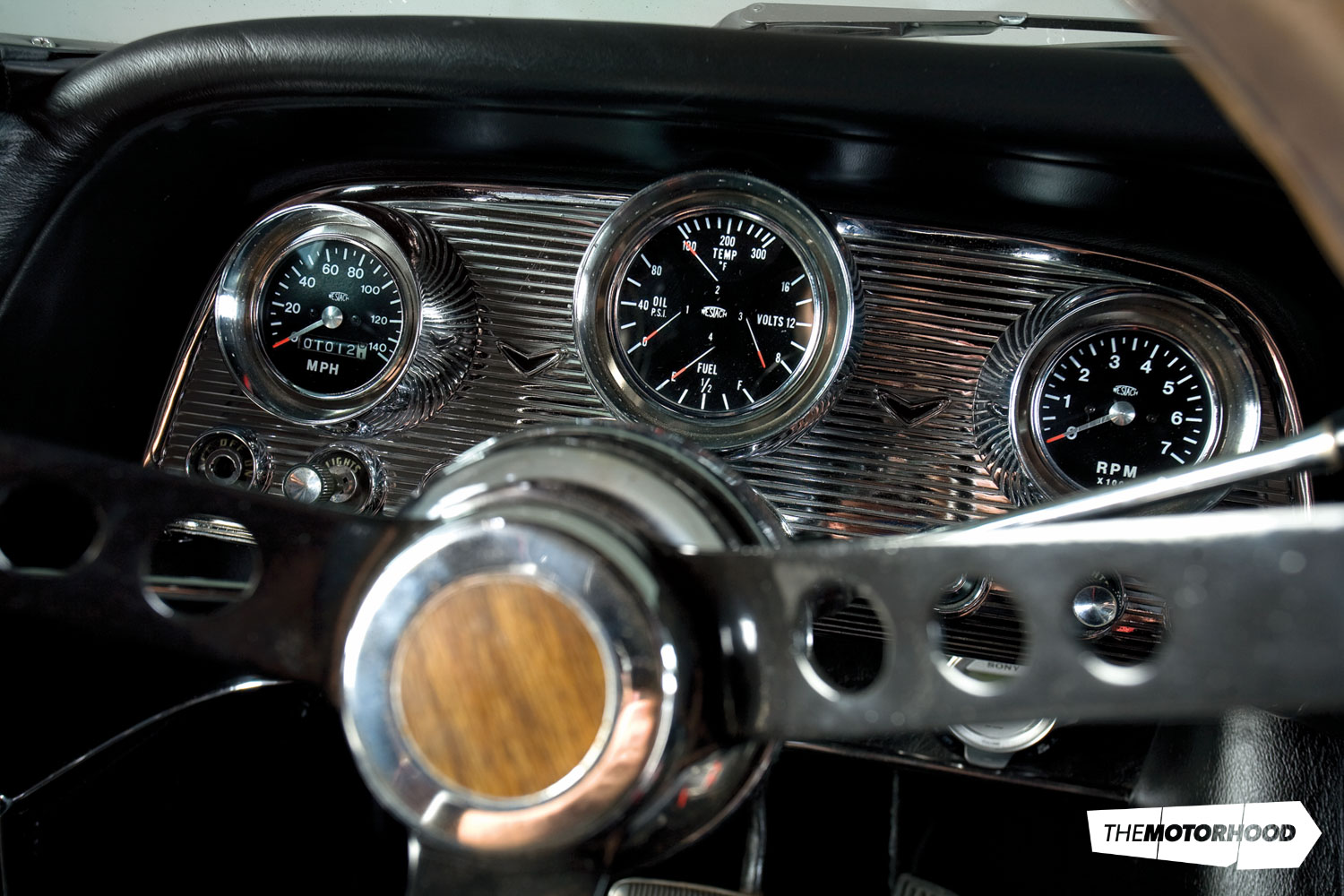
Knowing the joys of a good brake setup, Steve ditched the factory system and ordered himself a host of new parts from disc brake specialist Wilwood. These included four-pot callipers and slotted discs all around, a new master cylinder and a brake bias valve mounted inside the luxurious and fully leather re-trimmed cabin. The bias valve has been joined by a set of Westach gauges, a launch control switch and a simple but powerful amplified stereo system from Sony and JVC.
As the shoot begins to wrap up, I pore over the Ford’s most intricate details with amazement. Everything that at first looked so imperfect is in fact quite the opposite — pure perfection. I ask Steve, looking back over the last 14 years of the build, whether he would have done anything differently. “No, I wouldn’t change a thing,” he says. “If I had a different budget then sure, things would have been different, but I’m not a big money guy. I worked on this car over all these years when I could afford to and I’ve enjoyed it.” The rewards might have been a long time coming, but they sure as hell look to have been worth the wait.
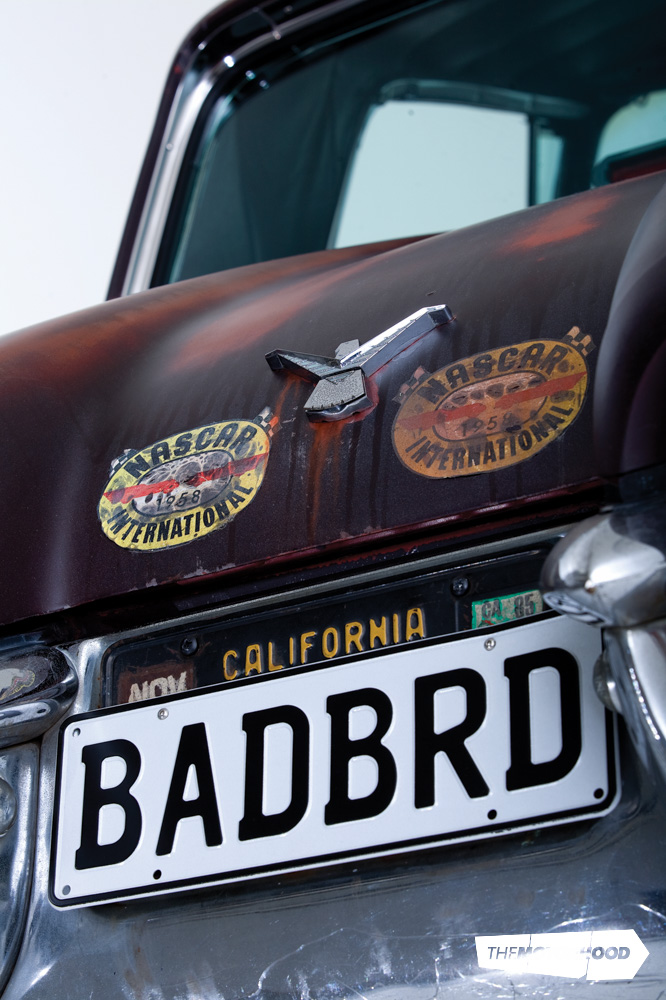
That old trick
The stickers that adorn the side of Steve’s car may look old but they were recently custom made. After searching the internet Steve and the self-proclaimed Paint Slut (Steve Levine) found exactly what they were after. Instead of purchasing them, they simply had them printed out as stickers. Then after they were applied to the vehicle, a heat gun was set on them, causing them to melt and giving an aged appearance.
Steve’s Thunderbird was featured in NZV8 Issue No. 42 (November 2008). You can grab a copy here.
Specs
-
Engine: 416ci (6817cc) Windsor, 400 Cleveland crank, polished shot peened Chrysler rods, Ross forged pistons, flat tappet cam, HV oil pump, ported 4V Windsor heads, 47cc heads, 10.5:1 compression, stainless valves, roller rockers, custom steel intake plenum, cold air intake, K&N filter, two Garrett GT35R turbochargers, 1.06 A/R exhaust housings, two 46mm Tial external wastegates, two 50mm Tial blow-off valves, PWR intercooler core, custom-built intercooler tanks, 1600cc Indy Blue injectors, 2000hp Barry Grant main pump, two lift pumps, 10-litre surge tank, Malpasi regulator, four Mallory wasted spark coils, 10mm leads, Autronic ECU, full four-inch stainless steel exhaust system, customised triple pass Howe alloy radiator, two oil coolers, power steering cooler, Morosso accumulator, Evacupan oil breather system
-
Driveline: C6 transmission, heavy duty input shaft, four Idler planetary gear sets, 3000rpm stall converter, flex plate clutch, 3.1:1 Detroit locker diff, 31-spline Moser axles, heavy duty driveshaft
-
Suspension: Koni adjustable shocks, custom coils, heavy duty sway bar, Nolathane bushes, five link rear suspension, rose-jointed panhard rod
-
Brakes: Wilwood four-pot callipers, Wilwood vented discs, Wilwood pads, Wilwood brake bias valve, Wilwood master cylinder, two remote boosters, vacuum pump, tank in guard
-
Wheels/Tyres: 15×8.5-inch Centreline Convo Pro front rims, 15×10.5-inch Centreline Convo Pro rear rims, BFG 265/50R15 front rubber, BFG 305/50R15 rear rubber
-
Exterior: De-badged, 1960 Thunderbird grille, custom 40-year-old-look paint, airbrushing and stickers
-
Interior: Full leather re-trim, electric seats, aftermarket steering wheel, Westach gauges, battery kill switch, launch control switch. Sony head unit, Sony amplifiers, JVC speakers
-
Performance: 720hp (537kW) at the flywheel at 5500rpm




